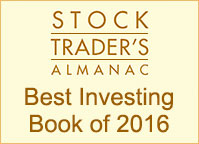
Nov 1, 2016 | ETFs, Options, Post of the Month, Stocks, VIX
The CBOE S&P 500 Volatility Index (VIX) soared another 8.79% today to 18.56 on news that a ABC News/Washington Post poll put Republican Donald Trump ahead of Democrat Hilary Clinton 46% to 45%, and on another inexplicable release from the FBI, this time of the record of its closed 2005 investigation of President Bill Clinton’s end of term pardon of fugitive financier Marc Rich.
On October 24 the VIX closed at 13.02. But that was before the end of election political storm broke. That’s a 42.5% move to the upside in a little over a week. (The VIX tracks the price that investors are willing to pay to hedge against a drop in the Standard & Poor’s 500 stock index.)
Of course, U.S. politics isn’t the only thing going on in the world. We’ve had positive and negative news out of China. Brexit continues to drive down the pound. The EuroZone economy can seem to get either inflation or growth moving upward. OPEC seems to have hit deadlock in its effort to reduce oil production by its members.
In my October 20 post “Specific volatility plays for a vulnerable market” http://jubakam.com/2016/10/specific-volatility-plays-for-a-vulnerable-market-options-on-the-vix-look-cheap/ I wrote that volatility seemed cheap given all the potential worries facing the market. And I suggested playing that cheapness/potential rise in fear by buying options on the VIX futures directly or by buying shares in a VIX ETF such as the ProShares Ultra VIX Short-term Futures ETF (UVXY). I suggested a 2X leveraged ETF like the ProShares ETF because the leverage would give you performance of something like that in the VIX futures themselves.
If you hit the October 24 low on the VIX exactly, you’d be looking at a 42.5% move to the upside. If instead you bought on October 20 when I posted, you’d be looking at a 28.8% move in the VIX.
For the ETF, from the October 24 low, the gain is 32.8%. From the time of my post on October 20, the gain is 15.1%.
Now, of course, the question is how much higher can fear go in the days before the U.S. election on November 8. I think fear has got a way to run in that very short-term. The FBI stands very little chance of getting far enough into its investigation of the Anthony Weiner/Huma Abedin laptop to tell voters any specific about what’s in the emails that it has found on that device. The polls will continue to tighten–if for no other reason than they almost always do in the closing days of a campaign as somewhat disaffect partisans return to the fold of their parties. Clinton’s huge Electoral College edge isn’t going to make Democratic voters and politicians any less anxious–Democrats frequently remind me of Cub fans in that they always see disaster around the next fly ball.
You still might be able to make 10% or so on the VIX, in my opinion. I do remind everyone that this was intended to be a very short-term trade and I wouldn’t hold this beyond election day or 22 on the VIX. Whichever comes first.
Full disclosure: I bought shares in the ProShares Ultra VIX Short-term Futures ETF for my personal portfolio three days after my October 20 post.

Oct 3, 2016 | Post of the Month, Stocks
Thursday the Wall Street Journal reported that Qualcomm (QCOM) was in talks to buy NXP Semiconductor (NXPI) for somewhere around $30 billion or roughly $90 a share. On Friday Bloomberg reported that NXP had hired an investment bank for advice on any offer.
For Qualcomm the deal would be a smart move. Growth in smartphones is slowing, posing a big challenge for Qualcomm to find more growth outside its core business. Buying NXPI would give Qualcomm immediate access to the automotive semiconductor market that Qualcomm (and everybody else) has targeted as a possible source of growth. As I’ve flagged in my Powerpoint presentations on the sector, the automotive semiconductor market is the fastest growing chip market now and is likely to stay so for at least the next five to ten years as car makers add more silicon to their products to turn them into Internet-connected entertainment and information platforms, and as they add chips to control everything from braking to fuel flow. Add on the possibilities for semiconductors in driver-assist technologies and maybe even a self-driving car and the automotive chip market is very attractive to any chip maker looking for growth. (Which is pretty much everyone.)
According to IC Insights the compounded annual growth rate for automotive semiconductors from 2013 to 2018 will be 10.8%. That compares to a 6.13% compounded annual growth rate for semiconductors as a whole. (And just 3.3% for computers and 6.8% for communications.)
With such an acquisition Qualcomm would go from a company with 90% of its business linked to the slowing smartphone market to a company with just 68% of sales in that sector, according to UBS.
Oh, and one last advantage to the deal from Qualcomm’s perspective: The company would be able to use the $31 billion in cash on its balance sheet to finance the deal. About $29 billion of that money is now trapped off shore and the deal would give Qualcomm a way to put it to use without repatriating the money and paying U.S. taxes on it.
The deal isn’t nearly as attractive–at this price–to NXP shareholders. I’ve seen analysts put a target price of anywhere from $115 to $170 a share on the company. At $90 a share or even at the $102.76 close today, October 3, Qualcomm would be getting a huge bargain. After all NXP Semiconductor’s 52-week range tops out at a closing price of $104. The shares have traded higher than that on an intraday basis and in June 2015 the shares traded at $114.
NXP Semiconductor shares have climbed after the Wall Street Journal story to above the reported Qualcomm offering price because traders are looking for another offer from, say, Broadcom (AVGO) or Texas Instruments (TXN). I’ve even heard mention of Intel (INTC) as a prospective buyer.
Wall Street thinks that Qualcomm has the inside track on any acquisition–assuming there is one. And I’d have to agree. Other possible acquirers are coming off big recent deals (Broadcom) or are so big and diversified (Intel and Texas Instruments) that buying NXP wouldn’t give their shares (which would be also the shares of current NXP stock owners after any deal) that same kind of bump that Qualcomm would get from a deal that would be clearly transformative for the company.
Which is why Wall Street has been busy raising its target price for Qualcomm. The stock closed at $67.11 today, October 5, but recent target prices have been in the vicinity of $75 to $80.
But they all do come with a caveat: Analysts are putting their $75 or $80 target prices on Qualcomm–if the company can buy NXP Semiconductor at $115 or $120 or less. At that level the acquisition would add 20% to 25% to Qualcomm earnings.
I own Qualcomm in my Dividend portfolio. I’m certainly holding the shares during all this M&A excitement and I’d buy more if the deal goes through at something like the analysts’ decent price. If you’re inclined to gamble, I’d say a bet that Qualcomm will be able to make this deal is a reasonably risky investment given the potential upside. At the current $102 and change, buying NXP isn’t extremely risky. The stock is likely to pull back if the deal turns out to be just a reporter’s nifty idea, but the stock isn’t that extended that any drop would be extreme.





